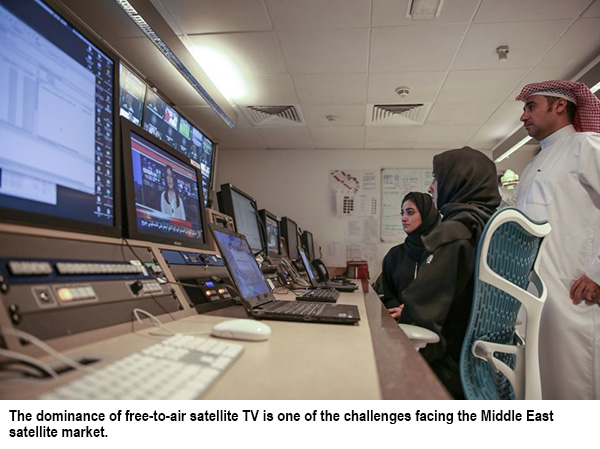Middle East Satellite Market Update
by Elizabeth Tweedie
Dubai, UAE, March 4, 2019--In common with the rest of the world, the market for traditional satellite services in the Middle East and Africa is facing challenges, from terrestrial competitors, new space competitors and shifting consumer taste. Nevertheless, all of the operators interviewed for this article, remain very upbeat about the prospects for their services in this region.
The broadcast market in the Middle East, has always been a challenging one for operators due to the dominance of free-to-air (FTA) TV. Over-the-Top (OTT) is an added and more recent challenge. Last year, Netflix produced its first Arabic original series. According to Price Waterhouse Coopers, while globally, by 2022 OTT will grow to 18% of consumer paid video revenues, in the MENA region, it will account for 24% of consumer paid video revenues. This fact has not escaped the notice of the satellite operators. Eutelsat for example has two products to support the rollout of OTT: SmartBEAM, launched in 2016, which delivers Internet Protocol Television (IPTV) via satellite, utilizing local WiFi networks for content distribution, and CIRRUS, a hybrid satellite-OTT platform, launched last year, offering content distributors the ability to simultaneously distribute content via satellite and OTT.
Traditional video, however retains its importance. Hamad AlMannai, Executive Director, Commercial, Es’hailsat commenting that the Direct-to-Home (DTH) will remain the most important segment in the near future, and the primary payload for the recently launched Es’hail-2. The main drivers of this video market are increasing demand for niche Arabic content and the conversion from standard definition (SD) to high definition (HD) and to a lesser extent ultra-high definition (UHD).
The operators are somewhat divided when it comes to 5G. Jacob Keret, Sr. VP Sales, Spacecom, stating: “We believe that 5G will take longer than pundits are currently reporting.” Nevertheless, he is expecting Amos 17 (due to be launched later this year), which includes a high throughput system (HTS) payload to be able to provide elements for IoT. Masood M. Sharif Mahmood, CEO Yahsat, somewhat concurs, expecting large scale 5G deployments to take a few more years. However, he does see that ultimately, 5G will create new verticals and applications. “With the promise of high bandwidth and low latency, 5G is not only going to open up new verticals and use cases, but continue to support traditional use cases for satellite systems like backhauling with an increasing demand to support the high bandwidth requirements.”
 Having said that it will be a few years before 5G becomes a significant market, it cannot be denied that many 5G networks are being launched around the world, including several in the Middle East. SES’ research leads them to expect that 30% of the region’s population will have 5G networks by 2025. Hussein Oteifa, General Manager, Sales, Middle East, SES Networks commented: “Given the diverse geographical landscape of the region, and satellite’s unique ability to connect remote areas, there is definitely huge potential to integrate high-performance satellite seamlessly into 5G networks and accelerate the rollout.” SES has been, and continues to be, very active in leading various demonstrations to ensure the seamless integration of satellite into 5G. “As 5G starts to gain traction, we predict that the major cities – usually terrestrially well-connected – will be the first to deploy it. Once the trend has caught on, telcos will want to roll it out in across provinces and countries – and this is where high-performance satellite will shine,” he added.
Having said that it will be a few years before 5G becomes a significant market, it cannot be denied that many 5G networks are being launched around the world, including several in the Middle East. SES’ research leads them to expect that 30% of the region’s population will have 5G networks by 2025. Hussein Oteifa, General Manager, Sales, Middle East, SES Networks commented: “Given the diverse geographical landscape of the region, and satellite’s unique ability to connect remote areas, there is definitely huge potential to integrate high-performance satellite seamlessly into 5G networks and accelerate the rollout.” SES has been, and continues to be, very active in leading various demonstrations to ensure the seamless integration of satellite into 5G. “As 5G starts to gain traction, we predict that the major cities – usually terrestrially well-connected – will be the first to deploy it. Once the trend has caught on, telcos will want to roll it out in across provinces and countries – and this is where high-performance satellite will shine,” he added.
A similar opinion was expressed by Es’hailsat’s Hamad AlMannai: “We expect these new technologies to have some impact on our business, however, given the ubiquitous coverage of satellite, we also believe satellites will be part of the solution to address some of the challenges facing telcos in rolling out these services in all areas. We can still address 5G backhaul for services that are not latency dependent. Moving forward we are evaluating partnerships for HTS and low earth orbit (LEO) constellations that will address the latency issue and provide IoT and 5G services via satellite.”
Possibly because IoT is essentially an extension to SCADA (Supervisory Control and Data Acquisition), a niche market that has always been open to satellite, the operators we spoke to, are all expecting IoT to be a viable market. Even Eutelsat, a strong video player, is launching a test LEO satellite as it views LEO constellations as highly suitable for IoT applications. SES is expecting its medium earth orbit (MEO) constellations O3b and the next generation mPower to be key in enabling the IoT market. O3b mPower, is a step change in capabilities, being ten times more powerful and more flexible than the current O3b satellites. First launches are scheduled for 2021.
Es’hailsat is evaluating partnerships for HTS and LEO constellations that will address the latency issues inherent with geostationary satellites, thereby providing an entrée into the IoT and latency sensitive 5G applications.
 Yahsat, following its acquisition of Thuraya last year, is uniquely positioned to address the IoT market, being able to offer both HTS in Ka-Band and Mobile Satellite Services (MSS) in L-Band. Following the launch of Al Yah 3 last year, Yahsat has extended broadband coverage to 19 additional African markets and Brazil. It’s MSS satellites (formerly Thuraya’s) cover two-thirds of the world. Masood M. Sharif Mahmood commented: “IoT, is enabling endless applications and uses, such as smart cities and efficient transportation, connecting billions of devices in the near future. This will require low bandwidth and various latencies, presenting us an enormous opportunity to capitalize on applications requiring seamless geographic access such as transportation and maritime.”
Yahsat, following its acquisition of Thuraya last year, is uniquely positioned to address the IoT market, being able to offer both HTS in Ka-Band and Mobile Satellite Services (MSS) in L-Band. Following the launch of Al Yah 3 last year, Yahsat has extended broadband coverage to 19 additional African markets and Brazil. It’s MSS satellites (formerly Thuraya’s) cover two-thirds of the world. Masood M. Sharif Mahmood commented: “IoT, is enabling endless applications and uses, such as smart cities and efficient transportation, connecting billions of devices in the near future. This will require low bandwidth and various latencies, presenting us an enormous opportunity to capitalize on applications requiring seamless geographic access such as transportation and maritime.”
No article about Africa would be complete without some mention of efforts being implemented to extend the reach of broadband to underserved communities. Towards the end of last year, Arabsat and Forsway joined together to deploy affordable satellite broadband services across Africa. Arabsat are providing capacity on BADR-7 and Forsway the customer premises equipment. Tobias Forsell, CEO, Forsway said: “We are excited to be working with Arabsat….to create a new way of delivering highly cost-effective broadband services in Africa”. Forsway’s hybrid router, Odin, can be deployed at a cost of around US$100 per station, thereby enabling Arabsat to offer broadband for around US$5 per month. Thus, helping bridge the digital divide in remote rural communities, as well as providing new, more reliable, and lower-tariff services to urban users.
Eutelsat is also active in efforts to bridge the digital divide and is working with a variety of local partners in Africa to deliver internet services under the name of Konnect Africa. Service was recently launched in the Côte d’Ivoire. The basic package there, offers 5GB of data for a cost of 9,000 CFA (~US$16).
Meanwhile Yahsat and Hughes have entered into a joint venture to provide commercial Ka-Band broadband services across Africa, the Middle East and southwest Asia. Hughes will provide the Jupiter system and also the operating and business support system (OSS/BSS). Satellite connectivity will come from Al Yah 2 and Al Yah 3. The venture will focus on both community hotspots and direct-to-premise service.
At the end of last year, the Society of Satellite Professionals International (SSPI) presented the Better Satellite World Award to Signatories of the Crisis Connectivity Charter. As we all know, satellites are essential in times of disaster when terrestrial communications are frequently destroyed or disabled. The linear nature of terrestrial communications frequently makes restoration a slow and difficult procedure. Satellite systems are often more resilient and can be restored more quickly. This award recognized the Charter as a key mechanism created between the satellite industry and the wider humanitarian community to make satellite-based communications more readily available to humanitarian and first responders and affected in times of disaster. Signatories to the charter include: Arabsat, Eutelsat, Thuraya, Yahsat and SES. The charter donation agreements provide three months bandwidth free-of-charge for humanitarian purposes.
September 25th this year will be a red-letter day for the UAE, and probably the region as a whole. On that day the first Emirati astronaut will travel to the International Space Station (ISS) for an eight day mission. He will travel there aboard a Soyuz-MS 15 spacecraft and return on a Soyuz-MS 12. Two Emiratis were selected for the UAE astronaut program, the second astronaut will continue training for future missions. The two astronauts are Hazzaa Al Mansoori and Sultan Al Neyadi, at the time of writing, it has not been disclosed which one will make the first journey.
------------------------------
 Elisabeth Tweedie has over 20 years experience at the cutting edge of new commmunications entertainment technologies. She is the founder and President of Definitive Direction (www.definitivedirection.com), a consultancy that focuses on researching and evaluating the long-term potential for new ventures, initiating their development, and identifying and developing appropriate alliances. During her 10 years at Hughes Electronics, she worked on every acquisition and new business that the company considered during her time there. She can be reached at etweedie@definitivedirection.com
Elisabeth Tweedie has over 20 years experience at the cutting edge of new commmunications entertainment technologies. She is the founder and President of Definitive Direction (www.definitivedirection.com), a consultancy that focuses on researching and evaluating the long-term potential for new ventures, initiating their development, and identifying and developing appropriate alliances. During her 10 years at Hughes Electronics, she worked on every acquisition and new business that the company considered during her time there. She can be reached at etweedie@definitivedirection.com





